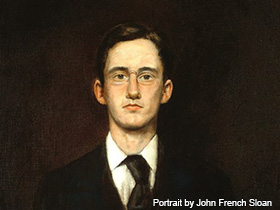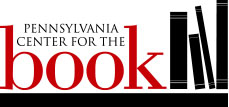You are here

8/2/1871 - 9/8/1951
Lock Haven's John Sloan was a ground-breaking realist painter.
John Sloan was an American artist known for his impact on the realism movement. Born in 1871 in Lock Haven, Pennsylvania, he spent most of his life in New York, where he worked as a painter, illustrator, and teacher for the Art Students League. As part of "The Eight," Sloan rebelled against the National Academy of Design for their conservative taste. His figure, landscape, and poster paintings are among some of the best examples of works depicting the realism movement of direct observation through individual responses that reflect on everyday life in America. Sloan died in 1951.
John French Sloan was the first child of James Dixon Sloan, an amateur painter and occasional businessman, and Henrietta Ireland Sloan, a local school teacher. He was born August 2, 1871, in the Pennsylvania town of Lock Haven. Both sides of his family were of Scottish decent, yet Sloan lived most his life believing he was Irish. In 1878, at the age of seven, Sloan, his parents, and his two sisters, Elizabeth and Marianna, moved to Philadelphia, Pennsylvania. This is where Sloan spent the remainder of his childhood. While his father embarked on business endeavors, his mother homeschooled the children. During his younger years, Sloan enjoyed keeping busy with his hands and adding to his personal collection of books. At the age of 16, Sloan quit his schooling and started working to help support his family.
An avid reader, Sloan's first job was with Porter and Coats, dealers in books and fine prints, where he was a cashier in the retail book department. It was through this job that he first became interested in art. Sloan became familiar with artists featured in Punch, a magazine that featured etchings by Rembrandt and Rubens. Sloan produced pen and ink copies of these prints and was permitted to sell each for five dollars. In the winter months of 1890, Sloan attended his first night drawing class at the Spring Garden Institution. One year later, he started his career as an artist, and he worked as an independent advertising artist in his personal studio.
Sloan attended the Pennsylvania Academy of Fine Arts in Philadelphia in 1892. It was here where he studied under Thomas Anshutz from 1892 to 1894. Through another teacher, Sloan met Robert Henri, with whom he exchanged numerous letters. During his time studying at the Academy, he worked for the Philadelphia Inquirer. In 1894, he had his first major recognition as a poster artist for work in the Chicago magazines Inland Printer and Chapbook. Around the same time, Sloan left the Inquirer for a position at the Philadelphia Press, where he became known for his elaborately graphic, highly stylized, colored art nouveau styled picture puzzles featuring curvilinear designs and for his comic strip riddles. Many of these works pictured women with hourglass figures, inspired by the world of fairy tales and folklore. His line work mimicked that of Japanese prints and elements of nature were often introduced as pattern, such as Football Puzzle featured in the Philadelphia Press, October 12, 1901. During his stay in Philadelphia, Sloan also did work as a book illustrator, contributing to Stephen Crane's Great Battles of the World in 1900 and creating drawings for Charles Paul De Kock's novels. In the year 1901, John French Sloan married Anna M. Wall, known as "Dolly," who continually supported him.
In 1904, following Henri, Sloan moved to New York, where he supported himself by selling his commercial art for magazine illustrations. Sloan and a group of seven other men rebelled against the National Academy of Design for their conservative taste, and they formed an independent exhibition in 1908. The group included: William Glackens, a fellow classmate from the Academy, George Luks, Everett Shin, Earnest Lawson, Maurice Prendergast, Arthur B. Davies, Robert Henri, and Sloan himself. "The Eight," as they were dubbed by the press, held their unromanticized form of realism exhibition at the Macbeth Gallery. They later became known as Ashcan artists for their true depictions of urban life. Aline Louchheim quotes Shin in her article, "Last of 'The Eight' Looks Back:" "We just painted what we were used to drawing and seeing." Their core belief was that the study of realism should be a direct observation through an individual response that reflected on the every day life in America. Hilton Kramer, an art critic for the New York Times, wrote of "The Eight" and John Sloan's success in "Illuminating a Period:" "Of the six realists in the group, it is John Sloan, I suspect, who was the most accomplished painter, and he was perhaps the only one whose painting both conformed for a time to the values put forth as the general tenets of the 'ashcan' school and managed to make something authentically pictorial at the same time."
Sloan is best known for his work at the turn of the 20th century, which primarily focused on images of New York. His etching series entitled New York Life, which depicted the essence of everyday city life, gained critical acclaim. Richard West quotes Charles Winser Barrell from the February 1909 edition of The Craftsman, "[John Sloan] has made his home in the heart of New York City in a picturesque top-story den on West Twenty-third Street, just on the outskirts of the seething Tenderloin. New York to him is America crystallized, and from his roof or studio window he can watch the pageant of humanity stream by in all its million phases." However, the series was also deemed "vulgar" for public display by the American Water Colorist Society. His "New York" works created many opposing views. Although they were being praised, the works were also criticized as vulgar, crudely finished, and lacking in aesthetic finishing of trained academic artistic practice. Through these trying times of criticism, Sloan successfully sold his first painting in 1913 after participating in the Armory Show at Lexington and Twenty Fifth Streets, which introduced Paris-based Modernism to America.
Sloan and his wife Dolly joined the Socialist party in 1910. He became a serious advocate for the party but insisted on keeping his political views separate from his artistic creations. From 1910 to 1912 he ran unsuccessfully as the Socialist party candidate for New York State Assembly. During this time he also took a position as the art editor for a socialist magazine entitled The Masses. However, in 1916, he resigned form the position due to a dispute on political content of an artistic work.
In 1916, Sloan started teaching at the Art Students League. He continued teaching there for the next 22 years. During his stay at the Art Students League, he served as the president in 1931, but his presidency only lasted one year. His students included some other known artists, such as Alexander Calder, David Smith, Reginald Marsh, and Barnett Newman. From 1918 until his death, Sloan also served as president for the Society of Independent Artists.
Sloan's painting technique in the early 20th century focused on a dark pallet with harsh marks of color, his technical practices focusing on the color system derived by Henri Maratta. During the late 1920s Sloan began a new painting technique of using opaque under paintings in tempera glazed over with layers of oil paints. Sloan used this layering of color technique because he felt that his work was stronger when form and color were painted separately. This period of his work focused on New Mexico landscapes and female nude model studies. His landscape inspiration came from his new summer residence in New Mexico, which he shared with his wife. Sloan later applied graphic lines and cross hatching to these works, combining both the graphic and painterly styles he had usually kept separate. Line work and gesture-like strokes took over his nude models, becoming an obsessive quality in his work. Goodrich comments on Sloan's later works: "His emphasis on [line] was linked to the comparative lack of substance in his early wok, and his highly conscious struggle to create form in his later work; it was a sign of experimental nature working things out stubbornly in his own way." This new technique of working created a signature style while emphasizing form, and it was a style of painting he continued using until his death.
During the 1930s, Sloan continued his printmaking endeavors while exhibiting works in the Whitney Museum. In 1939, Sloan wrote a book entitled Gist of Art, which outlined his motivations as an artist and teacher. One of his students, Helen Far, assisted him in the writing with her notes from class and interviews with fellow students. The first words that she heard Sloan say, which expressed his teaching philosophy as stated in Revolutionaries in Realism were: "I am not here to teach you young people any one way to draw - I am here to help you. I want to help you find a purpose, a reason for painting." In May 1943, Sloan's wife Dolly passed away, and the following year he married Helen Far.
In 1951, while preparing another exhibition for the Whitney rMuseum, Sloan and Helen spent the summer in Hanover, New Hampshire. They settled there because Sloan's doctor advised him not to travel to New Mexico due to the high altitudes. Sloan showed a new lyrical sense and palette of fresh colors. He felt misplaced amongst the green rolling hilled countryside of New Hampshire in contrast to the stark landscape of New Mexico. In August of the same year, Sloan was diagnosed with cancer and later died in Hanover on September 7, 1951.
Written
- Gist of Art. New York: American Artists Group, Inc., 1939.
- Revolutionaries of Realism: The Letters of John Sloan and Robert Henri. Princeton, NJ: Princeton UP, 1997.
Paintings
- Football Puzzle. Estate of John Sloan, 1901.
- Fun, One Cent. from the series New York City Life, Smithsonian American Art Museum, 1905.
- Fifth Avenue Critics. (from the series New York City Life) Delaware Art Museum, 1905.
- The Wake of the Ferry. Philips Gallery, 1907.
- Hairdressers Window. Wadsworth Athenaeum, Hartford, 1907.
- The Haymarket. Brooklyn Museum, 1907.
- Sixth Avenue and 30th Street. Collection of Mr. and Mrs. Jacob H. Rand, 1907.
- Indians on Broadway. Estate of John Sloan, 1914.
- Sixth Avenue Elevated at Third Street. Whitney Museum of American Art, 1928.
- Nude and Nine Apples. Whitney Museum of American Art, 1937.
- Brooks, Van Wyck. John Sloan: A Painter's Life. New York: Dutton, 1955.
- Coco, Janice Marie. "Sloan, John." American National Biography Online. Feb. 2000. 23 Oct. 2007. <>http://www.anb.org/articles/17/17-00804.html>.
- Fort, Illene Susan. "Sloan, John" Grove Art Online. 2007. Oxford University Press. 28 Sept. 2007. <>http://www.oxfordartonline.com/subscriber/article/grove/art/T079198?q=Jo....
- Goodrich, Lloyd. John Sloan. New York: Whitney Museum of American Art, 1952.
- Kramer, Hilton. "Illuminating a Period." New York Times 30 Apr. 1967: 133.
- Louchheim, Aline B. "Last of 'The Eight' Looks Back." New York Times 2 Nov. 1952: X9.
- West, Richard V. "John Sloan's Blue Kimono." Frye Art Museum. 2002. 10 Nov. 2007. <>http://www.fryeart.org/pages/sloanmain.htm>.
For More Information: Online galleries of Sloan's work may be found at the following sites:
- Fine Arts Museums of San Francisco.
- National Gallery of Art. <>http://www.nga.gov/cgi-bin/tsearch?oldartistid=28550>.
- Smithsonian American Art Museum. <>http://americanart.si.edu/collections/search/artwork/results/?&name=%20&....
Photo Credit: John French Sloan. "Self-portrait, 1890." 1890. Painting. Licensed under CC BY-SA 3.0. Cropped to 4x3. Source: Delaware Art Museum. Source: Wikimedia.
